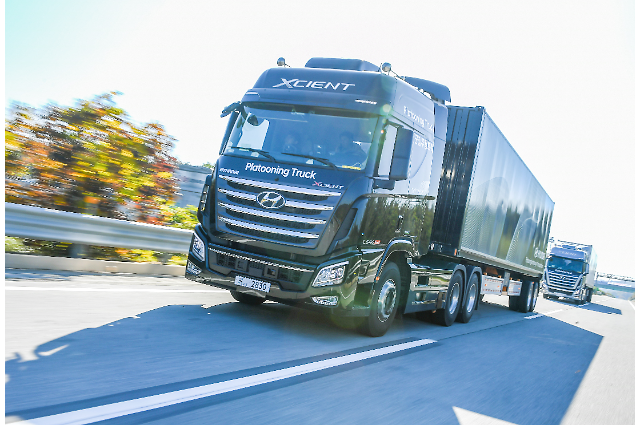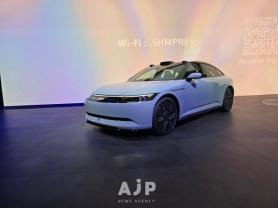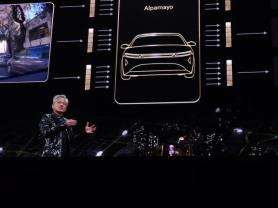
[Courtesy of Hyundai Motor]
SEOUL -- South Korea's Hyundai auto group moved closer to the commercialization of limited autonomous driving by commercial vehicles by carrying out the first successful platooning of 40-ton trailer trucks on a smart highway replicating real-world traffic conditions.
Two Xcient heavy trucks were mobilized for this week's demonstration on Yeoju Smart Highway, a 7.7 km testbed established for the development of autonomous driving technology, the group said in a statement. The demonstration displayed platooning, cut-in and out by other vehicles, simultaneous emergency braking, and vehicle to vehicle (V2V) communication, with the speed limit set at 60km per hour to ensure safety.
"We are confident that our industry-leading autonomous driving technology in commercial vehicles showcased in this platooning truck demonstration will lead into a revolutionary paradigm shift in the freight and logistics industry," said Jihan Ryu, head of Hyundai's commercial vehicle electronics control engineering division.
In the logistics industry, attention is being paid to "crowd" or cluster driving for large trucks that follow the moving range of a leading vehicle to increase stability. Hyundai Motor aims to secure the technology of crowd driving after 2020.
Vehicle platooning has the benefit of reducing air resistance to improve fuel efficiency and lower emissions, making it an eco-friendly technology. Upon the activation of a platooning mode, the following truck maintains a 16.7-meter distance and the driver's foot is off the accelerator or brakes.
The platooning mode activates lane-keeping technology, allowing the following truck's driver to take hands off the steering wheel. If other vehicles cut between the platooning trucks, the following truck automatically extends the gap to a minimum of 25m. When a leading truck makes an emergency stop, the following truck using a newly introduced technology responds quickly to decelerate and stop.
Hyundai said that a V2V system showed how real-time information shared by the two trucks can improve control over acceleration and deceleration, and incorporate ADAS (Advanced Driver Assistance System) information from various sensors. By displaying videos from the leading vehicle, the following driver can see the road ahead.
In August 2018, an Xcient truck loaded with car parts displayed a level-3 autonomous driving system for about 40 km on a busy highway, featuring lane keeping assistant and highway driving assistant. Level 3 provides self-driving features such as lane-keeping assistant and highway driving assistant. Level 4 requires no input from a driver if there is no dangerous situation.
Because large trucks with trailers require a more advanced and precise autonomous drive control system than passenger cars, Hyundai Motor has used differentiated precision sensing, judgment and control technologies.
Copyright ⓒ Aju Press All rights reserved.

![[CES 2026] Hyundai Mobis deepens future mobility push with Boston Dynamics, Qualcomm ties](https://image.ajunews.com/content/image/2026/01/08/20260108083201354738_278_163.jpeg)

